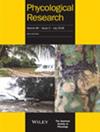Edaphophycus epilithus gen. et sp. nov. (Oscillatoriales, cyanobacteria) with a description of the morphology and molecular phylogeny
IF 1
4区 生物学
Q2 MARINE & FRESHWATER BIOLOGY
引用次数: 0
Abstract
Two strains of subaerial cyanobacteria were collected from two locations of the Republic of Korea, one in Seoul and the other in Gyeonggi‐do, both of which were studied using morphological and molecular traits. The genus Edaphophycus belonging to the family Coleofasciculaceae is morphologically very similar to the type genus Coleofasciculus and genus Kastovskya. However, in genera Coleofasciculus and Roseofilum thylakoids were reported as radial arrangements, whereas in genera Anagnostidinema, Geitlerinema, Kastovskya, and Wilmottia, belonging to family Coleofasciculaceae, thylakoids were reported as parietal arrangements, and in genus Edaphophycus in this study, thylakoids also appeared as parietal arrangements. Phylogenetic analysis of 16S rRNA showed that our two Edaphophycus epilithus strains clustered in the same clade, forming a sister relationship with genus Anagnostidinema. This suggested that our species belongs to the family Coleofasciculaceae. In addition, the ITS structure of E. epilithus showed different features when compared with genera Coleofasciculus and Anagnostidinema. These results demonstrated that E. epilithus sp. nov. is unique in morphology and molecular traits. Therefore, we propose this to be a novel species belonging to family Coleofasciculaceae and genus Edaphophycus gen. nov.Edaphophycus epilithus gen. et sp. 11 .(振荡菌目,蓝藻门)及其形态和分子系统发育描述
从大韩民国的两个地方采集了两株陆上蓝藻,一株在首尔,另一株在京畿道,这两株蓝藻都进行了形态学和分子性状研究。Edaphophycus属属于小蠊科,在形态上与模式属小蠊属和Kastovskya属非常相似。然而,在Coleofasciculus属和Roseofilum类囊体被报道为放射状排列,而在属于Coleofasicculaceae科的Anagnostidinma属、Geitlerinema属、Kastovskya属和Wilmottia属中,类囊体则被报道为顶叶排列,在本研究中,在Edaphophycus属中,类囊体也以顶叶排列出现。对16S rRNA的系统发育分析表明,我们的两个Edaphophycus epilithus菌株聚在同一个分支中,与Anagnostidinma属形成姐妹关系。这表明我们的物种属于小蠊科。此外,E.epilithus的ITS结构与Coleofasciculus属和Anagnostidinma属相比,表现出不同的特征。这些结果表明,E.epilithussp.nov.在形态和分子特征上是独特的。因此,我们认为这是一个新的物种,属于Coleofasciculaceae和Edaphophycus gen.nov属。
本文章由计算机程序翻译,如有差异,请以英文原文为准。
求助全文
约1分钟内获得全文
求助全文
来源期刊

Phycological Research
生物-海洋与淡水生物学
CiteScore
3.60
自引率
13.30%
发文量
33
审稿时长
>12 weeks
期刊介绍:
Phycological Research is published by the Japanese Society of Phycology and complements the Japanese Journal of Phycology. The Journal publishes international, basic or applied, peer-reviewed research dealing with all aspects of phycology including ecology, taxonomy and phylogeny, evolution, genetics, molecular biology, biochemistry, cell biology, morphology, physiology, new techniques to facilitate the international exchange of results. All articles are peer-reviewed by at least two researchers expert in the filed of the submitted paper. Phycological Research has been credited by the International Association for Plant Taxonomy for the purpose of registration of new non-vascular plant names (including fossils).
 求助内容:
求助内容: 应助结果提醒方式:
应助结果提醒方式:


